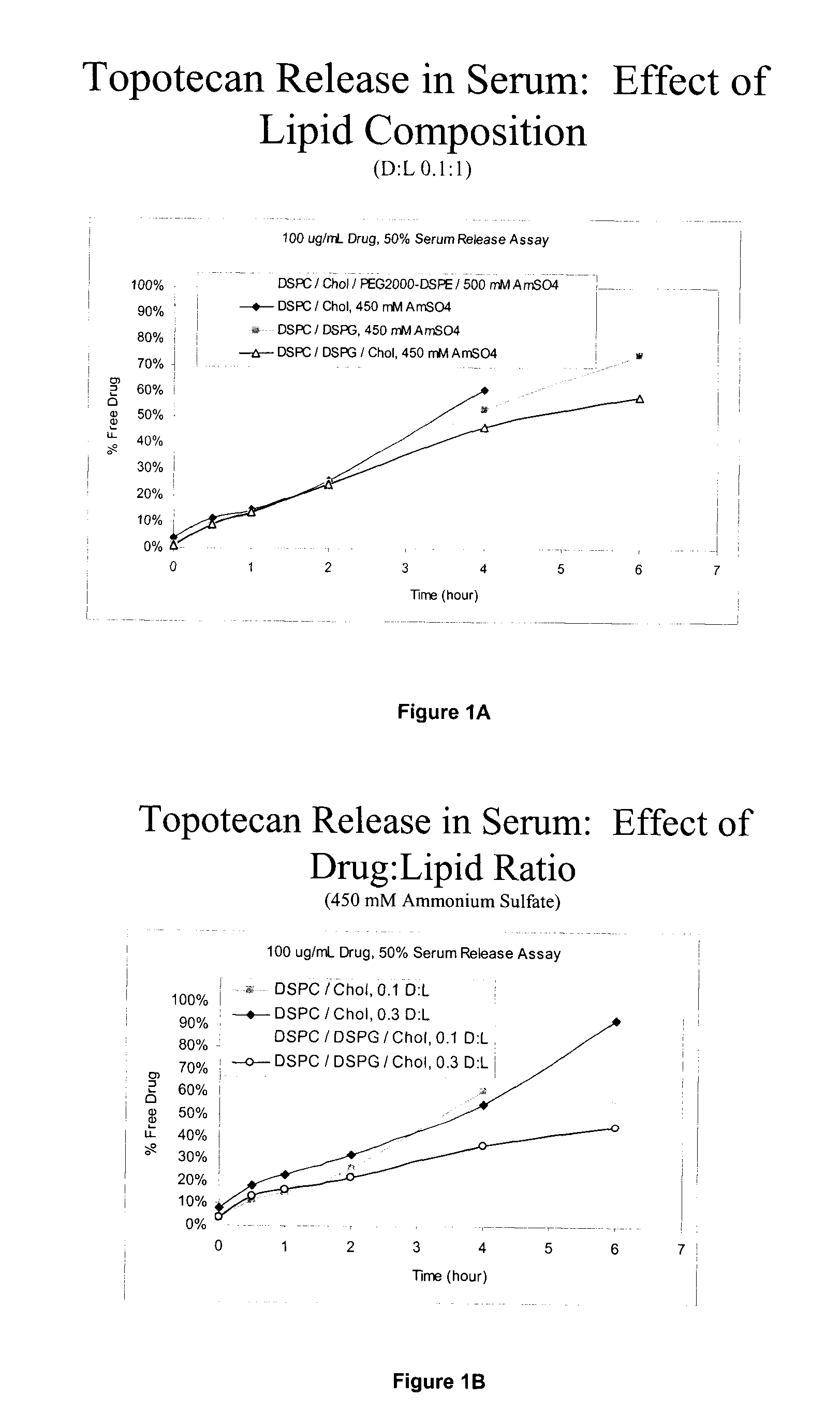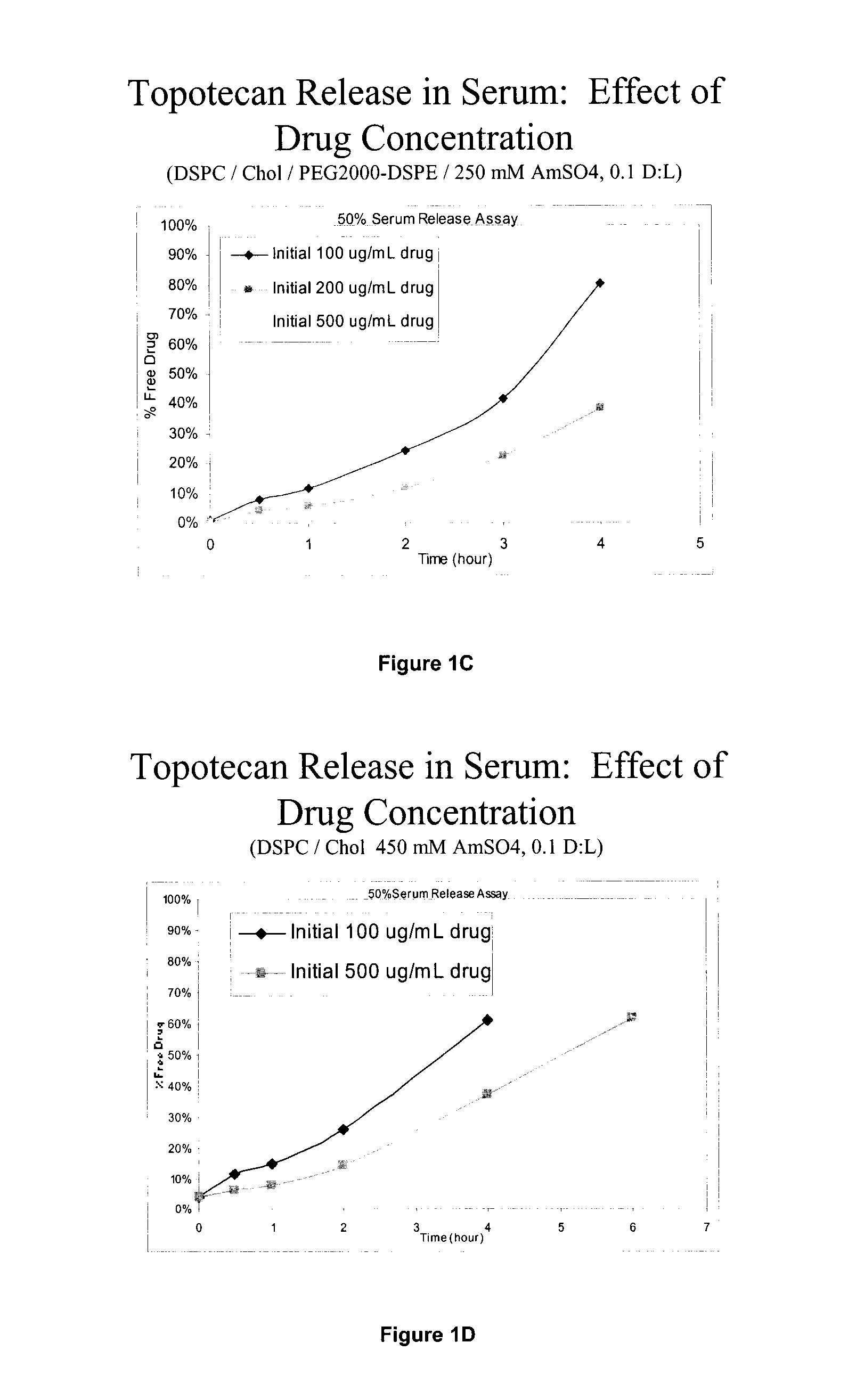Liposomal Composition for Convection-Enhanced Delivery to the Central Nervous Centre
a technology of convection and composition, applied in the field of liposomal formulations, can solve the problems of limited systemic treatment effectiveness, lack of efficacy, agents infused directly into the brain that are distributed poorly by diffusion, etc., and achieve the effects of improving tissue distribution, reducing toxicity, and increasing tissue distribution
- Summary
- Abstract
- Description
- Claims
- Application Information
AI Technical Summary
Benefits of technology
Problems solved by technology
Method used
Image
Examples
example 1
Comparison of PEGylated and Non-PEGylated Liposome Formulations for CED
example 1.1
Materials and Methods
Example 1.1.1
DSPC / CHOL (60 / 40 Mole Ratio)
[0091]Weigh 26.1 mg DSPC (MW 790; lot # C3L006; actual wt. 26.2 mg)+8.5 mg cholesterol (MW 387; lot # CH1S003; actual wt. 8.8 mg).
[0092]Dissolve in 0.5 ml chloroform; add 75 μl 5 mg / ml RhPE in EtOH (0.2 mole % of phospholipid).
[0093]Dry down the sample under nitrogen while vortexing to form a thin film. Finish drying under vacuum for 1 hour.
[0094]Rehydrate the lipids at 60° C. in 1.5 ml HBS (5 mM HEPES-145 mM NaCl pH 7.0; 0.1192 g HEPES [MW 238.3]+0.8475 g NaCl [MW 58.45], pH adjusted with NaOH, volume made up to 100 ml) to form MLVs.
[0095]Extrude at 60° C. through 2×100 nm filters to obtain LUVs (target size 100-120 nm).
[0096]Assay for phosphate—dilute to 20 mM phospholipids.
[0097]Vial in 2.0 ml serum vials (previously depyrogenated).
example 1.1.2
DSPC / CHOL / PEG2000DSPE (59.5 / 40 / 0.5 Mole Ratio)
[0098]Weigh 25.8 mg DSPC (MW 790; lot # C3L006; actual wt. 25.6 mg)+8.5 mg cholesterol (MW 387; lot # CH1S003; actual wt. 8.7 mg)+0.75 mg PEG2000DSPE (MW 2774; lot # PPE2011809; actual wt. 50 μl of 15 mg / ml solution in CHCl3; prepare 18 mg [actual 17.9 mg] in 1.2 ml CHCl3).
[0099]Dissolve in 0.5 ml chloroform; add 75 μl RhPE (0.2 mole % of phospholipid).
[0100]Dry down the sample under nitrogen while vortexing to form a thin film. Finish drying under vacuum for 1 hour.
[0101]Rehydrate the lipids at 60° C. in 1.5 ml HBS (5 mM HEPES-145 mM NaCl pH 7.0) to form MLVs.
[0102]Extrude at 60° C. through 2×100 nm filters to obtain LUVs (target size 100-120 nm).
[0103]Assay for phosphate—dilute to 20 mM phospholipids. Vial in 2.0 ml serum vials (previously depyrogenated).
PUM
| Property | Measurement | Unit |
|---|---|---|
| concentration | aaaaa | aaaaa |
| concentration | aaaaa | aaaaa |
| concentration | aaaaa | aaaaa |
Abstract
Description
Claims
Application Information
 Login to View More
Login to View More - R&D
- Intellectual Property
- Life Sciences
- Materials
- Tech Scout
- Unparalleled Data Quality
- Higher Quality Content
- 60% Fewer Hallucinations
Browse by: Latest US Patents, China's latest patents, Technical Efficacy Thesaurus, Application Domain, Technology Topic, Popular Technical Reports.
© 2025 PatSnap. All rights reserved.Legal|Privacy policy|Modern Slavery Act Transparency Statement|Sitemap|About US| Contact US: help@patsnap.com



